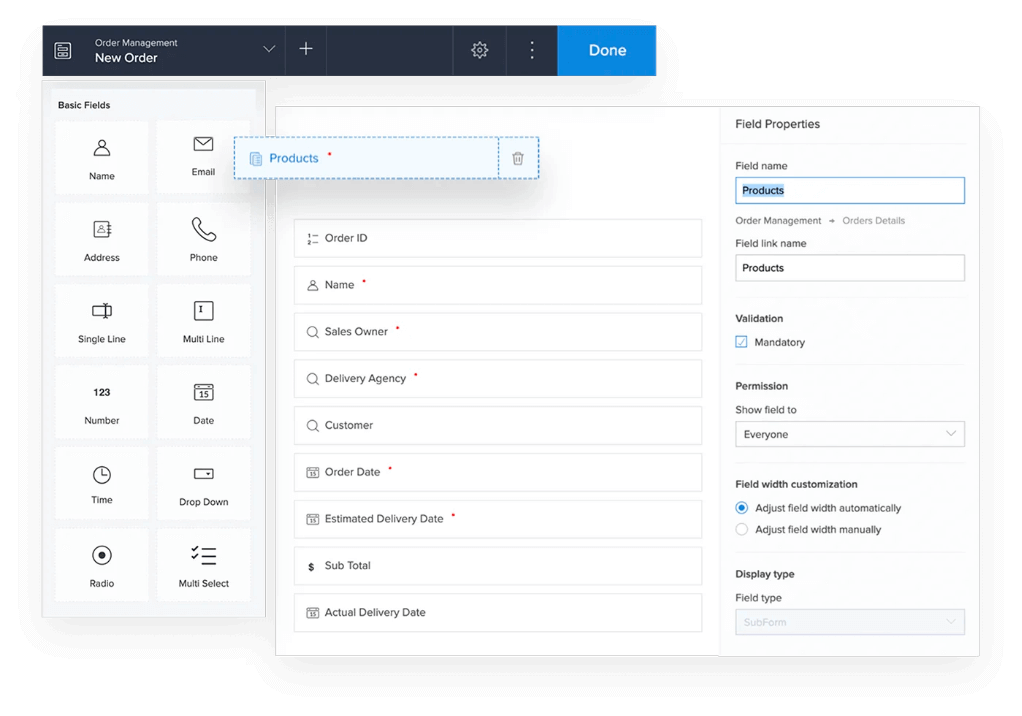Top Advice For Selecting Low-code platforms for application development
Top Advice For Selecting Low-code platforms for application development
Blog Article
Benefits Of Low-Code Application Development In Terms Of Accessibility For Non-Developers
Due to a number of factors due to a variety of factors, low-code development is more accessible for non-developers. These are sometimes referred to as "citizens developers."
Drag-and-Drop Builders: Low-code platforms offer drag-and-drop interfaces which allow non-developers to create applications visually without having to write code. This makes development more accessible to people who have little or no technical skills.
WYSIWYG editor: "What you see is the result you get" editors let users design interfaces, workflows, and other features in a way which closely resembles the final product. They are easier to comprehend and utilize.
Simplified design of Workflow and Logic
Visual Workflow modeling: Users can design business processes and application logic with visual flowcharts. These models are more intuitive to work with than traditional method of programming.
Pre-built Components of Logic: Low-code platforms typically include already-built logic (e.g. loops and conditional statements) which can be easily adjusted, thus reducing the need for complex programming.
Reusable Components and Templates
Library of Pre-built Templates: A lot of low-code platforms provide a library of templates for common application types, enabling non-developers to start from a solid base and alter as required.
Reusable widgets and Modules : By using modules or widgets that can be reused users can streamline the creation process by reducing the requirement for detailed technical knowledge.
Tutorials and guides for development:
Step-by-Step Guides: Platforms usually offer a set of development guides as well as tutorials and on-screen tips to assist non-developers in creating applications.
Interactive Tutorials. Interactive, hands on tutorials allow users to learn through doing.
Integration with existing tools:
Easy Integration: Low-code platforms have been designed to integrate easily with the existing business tools and systems (e.g., CRM ERP, CRM) which allows non-developers to build applications that fit with their existing workflows.
APIs and Connectors: APIs integrated into connectors and APIs enable non-developers and users to easily connect applications with external services without the need for complicated programming.
Collaboration Features:
Team Collaboration Features, like real-time collaboration and shared workspaces, enable professionals and non-developers to work together effectively.
Access Control based on Role: Users who are not developers can be assigned roles and access levels. This lets them contribute to development without compromising security or functionality.
Automated Testing and Debugging:
Low-code platforms often come with an integrated testing and debugging tools that makes this process easier. Non-developers are now able to ensure their application works correctly.
Error highlighting: The system points out problems and offers solutions to guide non-developers.
Development using low-code is more accessible to non-developers because it makes development more accessible to everyone. Platforms with low-code enable business users by providing them with easy-to-use, visual and guidance tools. They are then able to actively contribute to the development and maintaining applications. Check out the top Low-code Platform for application development url for website info including driver jdbc, cross platform mobile development, sso azure, app modernization, azure sql databases, low code development platforms, cross platform app dev, cross platform mobile dev, rad application development, app platforms and more.
Advantages Of Low-Code Application Development In Terms Of Cost-Effectiveness
Low-code application creation offers many advantages in terms of cost-effectiveness. Companies looking to optimize budgets can take advantage of this option while delivering quality applications. These are the main benefits: Reduced Development Costs:
Low-Code Platforms: Low-code platforms reduce the amount of manual coding needed, which in turn saves developers time and energy in the process of creating applications. This leads to lower costs of labor.
We require fewer resources for developers. Programming low-code is faster and easier which means that fewer developers with specialized skills are needed. This will drastically lower the cost of hiring and staffing.
Speedier Time to Market:
Accelerated Development Cycle Visual tools for development and the pre-built parts offered by low-code platforms facilitate rapid development of applications, which allows companies to get their products on market quicker. This will result in faster revenue growth and improve the competitive position of their products.
Rapid Prototyping: Businesses can quickly create prototypes and then test them, which can cut down the amount of time needed during the development process and allowing for faster iterations based on user feedback.
Lower Maintenance Costs:
Simple Maintenance: Applications developed using low-code platforms are generally more simple to maintain due to their modular components and standard architecture. This reduces the cost of maintaining the system over time.
Automated Updates. Many low-code platforms manage patches and updates automatically. Applications are secure and safe without needing extensive manual input.
Efficient Resource Utilization:
Low-code platform contributions allow business users as well as other non-developers participate in the process of creating. This openness of the development process enables firms to make use of the skills and abilities of a broader range of employees.
Improved utilization of IT resources IT departments get the opportunity to focus on more strategic projects instead of getting bogged down with simple work tasks for development. Overall productivity and efficiency are increased.
Scalable Pricing Models:
Subscription pricing: Many low-code platforms offer flexible pricing plans for subscriptions that scale with usage. This gives businesses the capability to match their spending to the growth of their business and its needs without the need for large upfront costs.
Pay-Ass-You-Go Options: Certain platforms offer pay-as-you-go options that guarantee companies only pay when they make use of resources. This can be especially beneficial for small and start-up companies with small budgets.
Reduced Third-Party Software Costs:
Low-code platforms usually come with integrated functions that eliminate the requirement to purchase additional software or tools. This can save you money on subscriptions and licensing costs.
Pre-Built Integrations: The possibility of having pre-built integrations with the most well-known systems and services reduces the need for the need for custom development. Savings on both time as well as cash.
Higher ROI
Faster Return on Investment: The combination of speedy development, less expensive and faster time to market means businesses will see a higher ROI (ROI) on their apps.
Enhanced Agility: Businesses can rapidly adapt to market trends and the needs of customers, ensuring that they stay relevant and can capitalize on new opportunities that arise.
Training costs are less:
User-Friendly Interfaces: The user-friendly interfaces and user-friendly features of low-code platforms minimize the learning curve, thereby reducing the need to conduct intensive training.
Accessible Resources: Many low code platforms come with complete tutorials and training materials as well as community support. These tools reduce the requirement for formal education and the associated cost.
Collaboration is made easier:
Improved Collaboration Tools: The integration of collaboration tools allows more effective communication between team members as well as an improvement in overhead for projects.
Unified Development Environment : A unified environment makes work easier and lowers the cost that are associated with managing different tools and platforms.
In the end, the value of developing low-code applications stems from its ability to cut development and maintenance costs and speed up time to market, maximize the utilization of resources, and offer flexibility in pricing. This mix of elements gives firms significant financial benefits and makes low-code an appealing option for businesses looking to make the most of their budgets for development, yet still creating robust and scalable applications. Take a look at the top rated official statement for site advice including develop web application, build with docker, push alerts, push notifications, app dev platform, develop web application, rapid action development, develop mobile application, application modernisation, rapid application design and more.
The Advantages Of Low-Code Development For Community Members And Vendors
Low-code platform development has many advantages, including support from the vendor and community support. This is essential in ensuring successful application development along with ongoing maintenance and continual improvement. Here are some key benefits.
Comprehensive Technical Support:
Support Team with Dedicated Staff: Many low-code platforms have a dedicated support staff that are on hand to assist with technical queries in troubleshooting and advice. They can make sure that problems are solved promptly.
Support is available 24/7: Numerous vendors offer round-the-clock support, which can be particularly useful for businesses that operate across different time zones.
Training and Onboarding
Structured Training Programs: Many vendors provide structured training programs which include webinars, tutorials and courses for certification, to assist users in getting up to speed on the platform quickly.
Customized Onboarding A lot of vendors offer individualized services to assist their new customers get onboard successfully and tailor it specifically to their requirements.
Updates and regular updates:
Continuous Improvements: Low-code companies frequently release updates, which include performance improvements, new features and security patching, to keep the platform up-to-date.
Feedback Integration: Vendors frequently incorporate user feedback into their development processes, ensuring that their platforms evolve to meet the evolving demands of its customers.
Comprehensive Documentation:
Documentation - Detailed Documentation: A complete and well organized documentation that covers everything from basic usage to advanced customisations and is usually available. This lets users tackle problems on their own.
API References API documentation can assist developers build and integrate apps with the Low-Code platform.
Consulting and Professional Services
Expert Consulting: Vendors typically provide consulting services that assist with planning for strategic purposes architectural design, as well as complicated implementations, to ensure that users can leverage the platform to its fullest potential.
Custom Development Services Certain vendors provide custom development services to develop specific integrations and features that are not available as standard.
Community Support for the Community
Active User Communities:
Discussion boards and forums: Many platforms with low-code have vibrant online community for users to seek help, share solutions and collaborate to find the best methods.
User Groups and Meetups: Local or virtual user groups and meetings offer opportunities for learning, networking and sharing your experiences.
Collaboration and Knowledge Sharing
Community-Contributed Resources: Users often share templates, modules, and extensions that they have developed, which can be reused or adapted by others, accelerating development and innovation.
Crowdsourced Solution Finding: The collective wisdom and experience of a group could be an excellent resource for solving complex issues.
Learning and Development
Community-Led Learning: Many communities host training sessions, workshops and webinars that are often run by experienced users who can provide insights and techniques that are more advanced.
Online Tutorials and Courses: The community members frequently share and create online tutorials, classes, and tutorials on how to accomplish things that enhance learning resources.
Feedback and Influence
Product Feedback Channels. Community forums usually include channels where you can provide feedback to the manufacturer. This feedback may influence the design and development of features.
Beta Testing Programs: Active members of the community may be eligible to participate in the beta testing program. This will give them the chance to see first-hand new features, and an opportunity to shape the future of the system.
Recognition and encouragement:
A lot of vendors offer community recognition programs. These programs honor active community members and include MVP programs.
Peer Support: Members of the community often provide peer support by sharing their knowledge and providing advice to less experienced users creating a more collaborative and a supportive atmosphere.
Overall, the combination of robust vendor support and an active, engaged community provides a comprehensive support ecosystem for the development of low-code applications. The developers will have the expertise and resources they need to build and deploy their application.